EventEspresso.com just got a fresh makeover; enjoy the new brew! ☕️
EventEspresso.com just got a fresh makeover; enjoy the new brew! ☕️
Today we learn how to use Twitter Marketing to drive traffic to your event website and boost ticket sales to your events.
Posted by Seth Shoultes
This week we’ll be taking a deep dive into using Twitter marketing to build awareness around your events. I’ll try to cover everything related to Twitter marketing and how to employ it as a tool for event marketing. I’ve included a lot of information in this post, so if you already know about Twitter, or don’t care about seeing Twitter stats, please feel free to skip ahead. I’ve outlined the topics for you below.

Here are all the different Twitter Marketing topics I’ll cover:
Last week I covered Facebook Marketing in great detail. Make sure you check it out, especially if you to reach a wider audience than what’s on your email list.
If you aren’t already aware, Twitter is a social networking and microblogging service, enabling registered users to read and post short messages, so-called tweets. Tweets are limited to 140 characters and users are also able to upload photos or short videos.
Founded in 2006, Twitter turns 11 years old this year, making it one of the oldest of the social networking family. The platform’s 313 million monthly active users send more than 500 million Tweets every day. More importantly for marketers, Twitter users are actively discovering and interacting with businesses through the social network.
Over 66 percent of Twitter users have found out about a new small or medium-sized business (SMB) through the network, 79 percent have retweeted an SMB, and a whopping 94 percent plan to make a purchase from the SMBs they follow. And that’s not all. Over 69 percent of Twitter users have already purchased from an SMB because of something they saw on Twitter.
Click to view infographic
Twitter has an enormous international presence, with 79 percent of its users living outside the US. It’s supported by 35 languages around the world, and the platform has also recently switched away from a live feed for a more tailored experience. It was found in 2016 that Twitter had approximately 320 million active users visiting on a monthly basis.
Here are some interesting Twitter stats:
The approach you take to every social media site should be different for each platform. For example, your Twitter marketing strategy isn’t going to be the same as your Facebook marketing strategy. Understanding how Twitter works and where it fits in the social media landscape will help shape the way you use it.
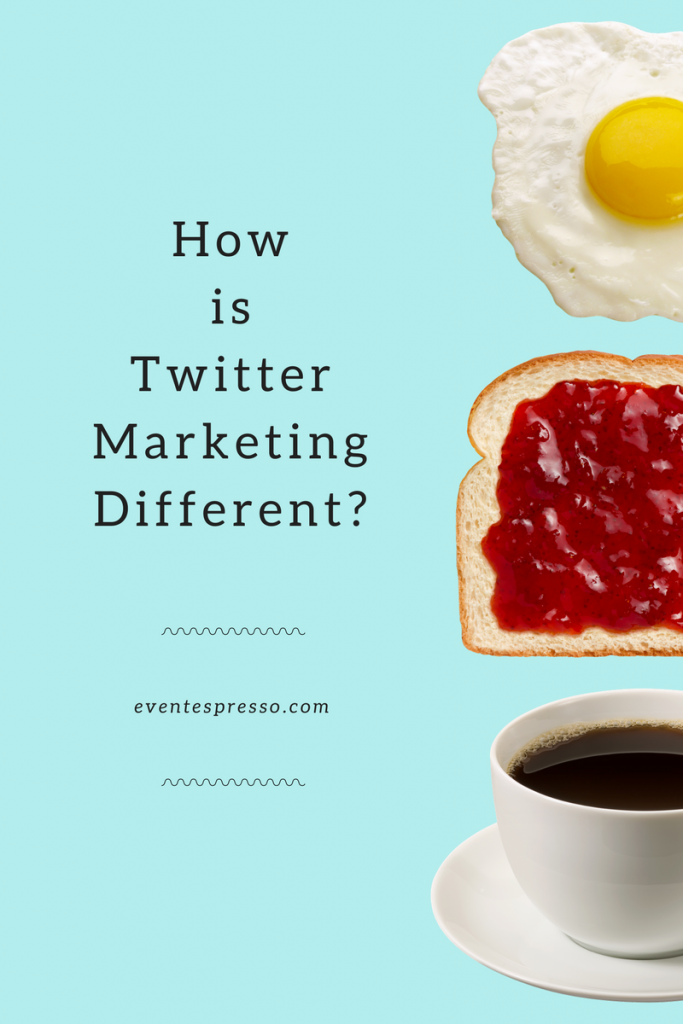
Some of the main ways many businesses use Twitter include:
As you can see, most of these activities have to do with interactions. It’s not necessarily just about broadcasting your content like Facebook, Instagram or Pinterest, for example. Twitter flourishes off of communication.
How can using Twitter marketing help your event marketing strategy? Twitter can help your event marketing strategy by allowing you to build interest in your events, as well as your event business. On Twitter, the follower relationship is not two-way; you don’t have to wait for someone to approve “your” follow request and vice versa. Your Twitter updates are public as well, meaning non-Twitter users can also view them. For event organizers, this means you can easily get a quick message out to people who are interested in your upcoming events, activities, or products. You can also use Twitter to get real-time feedback from event attendees, members, and customers.
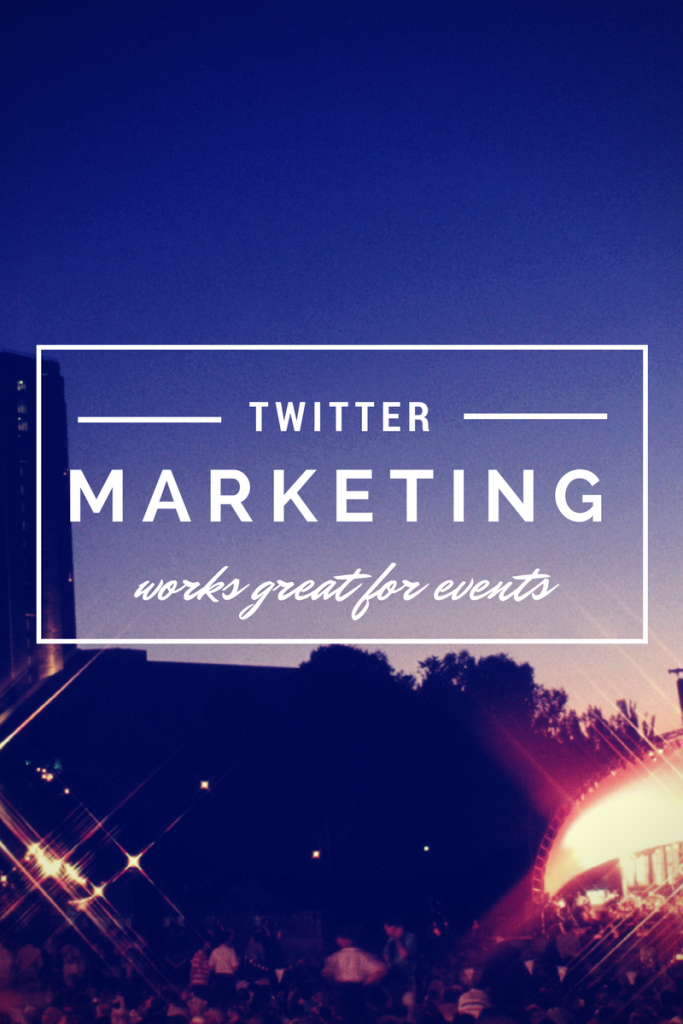
When you follow someone on Twitter, you’ll see that person’s tweets in real time on your personal Twitter page, along with updates from everyone else you follow. If you follow many people, this can get a bit noisy, especially if those people are heavy users of the site. That said, another beauty of Twitter from a business perspective is the ability to search all updates for a specified term or phrase (using http://search.twitter.com), as the search spans the entire public “Twittersphere” and not just your followers. (This is especially useful when looking to keep tabs on customer service issues at all stages of your event.)
Nothing should stop you from using Twitter in your event marketing strategy. However, I think it’s fun to share a few pros, and cons about each social media tool I review.
Pros:
Cons:
Here are some tips I’ve compiled to help you use Twitter marketing for your events (and your event business).

If your event happened twice a year, keep the same page and only adjust the cover photo and profile image to reflect the upcoming show. Make sure to keep your page title and URL generic, and not unique to one year.
While Twitter is fantastic for in-event engagement, you’ll need to use it before and after your event to maximize your social ROI with the platform. One of the many benefits of using Twitter is that it allows you to build and strengthen the many relationships that you have with your audience. Just make sure that you are taking the necessary steps to engage your followers throughout all stages.
Here are some tips to help at the different stages:
From the Twitter website, a list is a curated group of Twitter accounts. You can create your lists or subscribe to lists created by others. Viewing a list timeline will show you a stream of Tweets from only the accounts on that list.
The right Twitter list can help you locate, monitor and interact with the right people quickly. You can sort individuals or brands that interest you into Twitter lists (which can be public or private). Once you’ve added a user to one of your Twitter lists, you can easily see what they’re posting and sharing.
You can even create Twitter lists of invited, proposed, and registered attendees, and then engage with them by retweeting their comments or mentioning them in your Tweets. (For more information about creating a list on Twitter, please view the documentation.)
Here are some additional ideas on how to leverage Twitter lists:
After someone registers for your event, encourage them to share that they’re participating on Twitter. “Make it easy by including a ‘lazy tweet’ — a link with a pre-populated tweet including the desired copy and hashtag — for people to share instantly to maximize your social reach before the event,” writes Taylor Carrado at Hubspot. (If you’re an Event Espresso user, check out the Events Social Sharing add-on.)
Hashtags (ex. #MyGreatEvent) help attendees find others on social media who are talking about your event. When coming up with a hashtag, make sure to choose one that isn’t already in use by someone else, that is memorable (which usually means short), and that describes your event. Once you’ve picked your hashtag, make sure to include it in all event-related content, even paper invitations or flyers, to make sure people know how to follow along with your event online. (If you’re running a WordPress website, plugins like Better Click to Tweet are ideal for creating tweetable content for your website visitors.)
“Pick an event hashtag that’s short, and ideally, unique to your event,” writes Andy Crestodina on the Orbit Media Blog. “And always, always use this hashtag in every tweet and post.”
Unlike most social networks, Twitter doesn’t curate the content you see by using an algorithm. Instead, the reverse chronological timeline displays Tweets from everyone you follow in one continuous stream. The sheer volume of tweets means that a single tweet about your upcoming event is expected to be missed by a large number of your followers.
Don’t be afraid of tweeting the same content more than once. In fact, one study suggests that the second or third tweet relating to a particular topic may perform better than the first.
While it may be a good idea to publish several tweets pointing to the same event content, making sure the text and image of the tweet are different each time ensures that your feed looks more engaging and entertaining. This method of sharing also allows you to analyze the types of Tweet that are most successful, by looking at clicks and engagement in an analytics platform, such as Google Analytics or Twitter Analytics.
A majority of your attendees may be live-Tweeting throughout the day, so this is also an excellent opportunity to engage your participants and leave a lasting impression of your event. As mentioned above, in the previous tip, it’s also a great strategy to get those involved that weren’t able to attend in person. Overall, keeping your company’s Twitter feed active throughout your live event is essential to ensuring the success of your Twitter campaign.
On the day of your event, you may want to designate a person (or people) to manage your company’s Twitter account. This individual will have several responsibilities, including posting tweets, quoting speakers, answering attendee questions, sharing photos and videos, making announcements, re-tweeting good posts, and more.
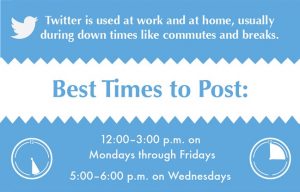 Last, but not least, find out the best time to post for your business. People log in to Twitter on both mobile devices and desktop computers, both at work and at home.
Last, but not least, find out the best time to post for your business. People log in to Twitter on both mobile devices and desktop computers, both at work and at home.
According to Hubspot, the best time to post on Twitter is 12:00-3:00 p.m. on Mondays through Thursdays, and 5:00-6:00 p.m. on Wednesdays. However, these might not be the best times to post for you, especially if you want to engage with potential attendees. Which brings us to.
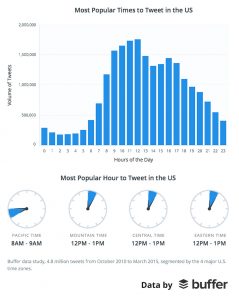 , a scheduling and analytics app for the major social platforms, analyzed all of the tweets that have been sent through their service since October 2010, giving them over 4.8 million tweets to examine. What they found, is that people love to tweet and eat. Noon to 1 p.m. is probably the most popular time to tweet. However, it’s not necessarily the most productive time to tweet. With so many tweets blasted out every minute, it’s easy for yours to get lost in the mix. As you can see in the related image, the most popular times to tweet seems to be 8:00-9:00 a.m. Pacific Time and 12:00-1:00 p.m. in Mountain, Central, and Eastern Time. So you need to know your delegates fairly well.
, a scheduling and analytics app for the major social platforms, analyzed all of the tweets that have been sent through their service since October 2010, giving them over 4.8 million tweets to examine. What they found, is that people love to tweet and eat. Noon to 1 p.m. is probably the most popular time to tweet. However, it’s not necessarily the most productive time to tweet. With so many tweets blasted out every minute, it’s easy for yours to get lost in the mix. As you can see in the related image, the most popular times to tweet seems to be 8:00-9:00 a.m. Pacific Time and 12:00-1:00 p.m. in Mountain, Central, and Eastern Time. So you need to know your delegates fairly well. 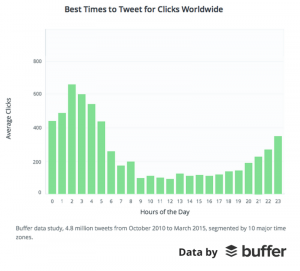 “In many cases, 70 to 80 percent of total engagement comes from clicks,” says Kevan Lee of Buffer. The highest amount of engagement per tweet occurs between 11 p.m. and 5 a.m., peaking between 2 a.m. and 3 a.m.Tweet when fewer people are tweeting to increase your chances of being noticed.
“In many cases, 70 to 80 percent of total engagement comes from clicks,” says Kevan Lee of Buffer. The highest amount of engagement per tweet occurs between 11 p.m. and 5 a.m., peaking between 2 a.m. and 3 a.m.Tweet when fewer people are tweeting to increase your chances of being noticed. 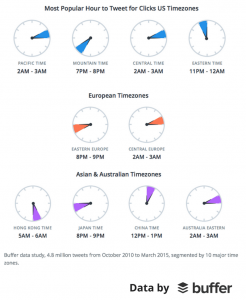 Los Angeles, San Francisco, etc. (Pacific Time): 2 a.m.
Los Angeles, San Francisco, etc. (Pacific Time): 2 a.m.
Here’s a list of instruments I’ve compiled to help you tweet efficiently. We use many of these tools in our Twitter marketing strategy as well.
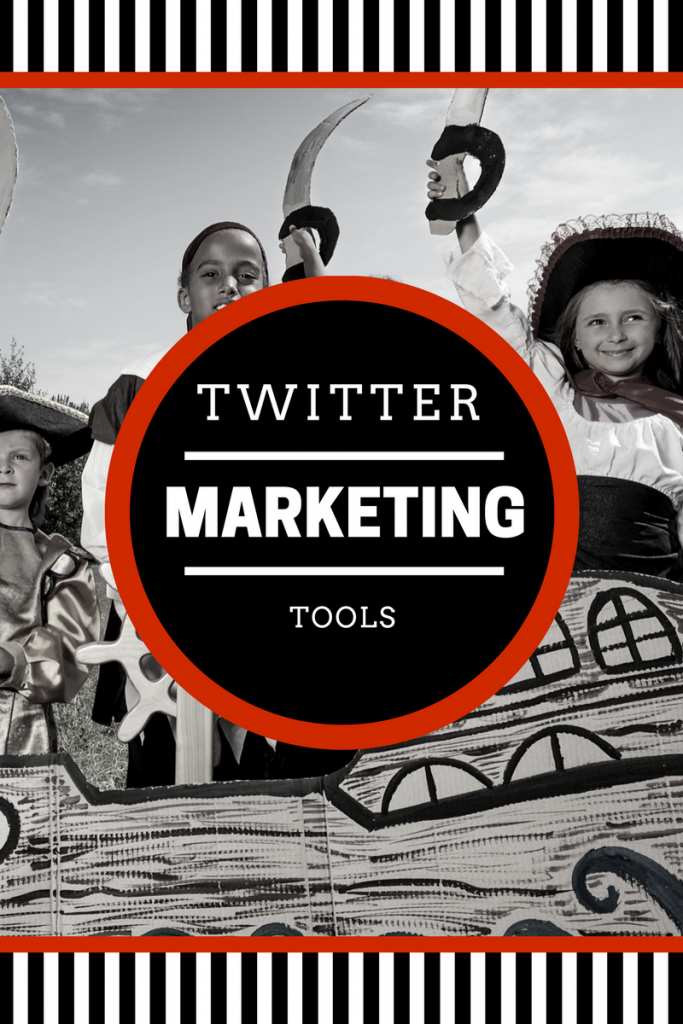
If you’ve made it this far, there’s no question that you know the importance of keeping everyone engaged before, during, and after your event. You know that sharing information about your events, at all stages of your event can, and will increase exposure and build awareness around your event. Hopefully, you have a deeper understanding of Twitter marketing and can see how effective Twitter can be for sharing information about your events, updates with your attendees, and keeping everyone engaged before, and after your event.
Do you actively make an effort to integrate Twitter Marketing with your events? I’d love to hear why or why not in the comments below.